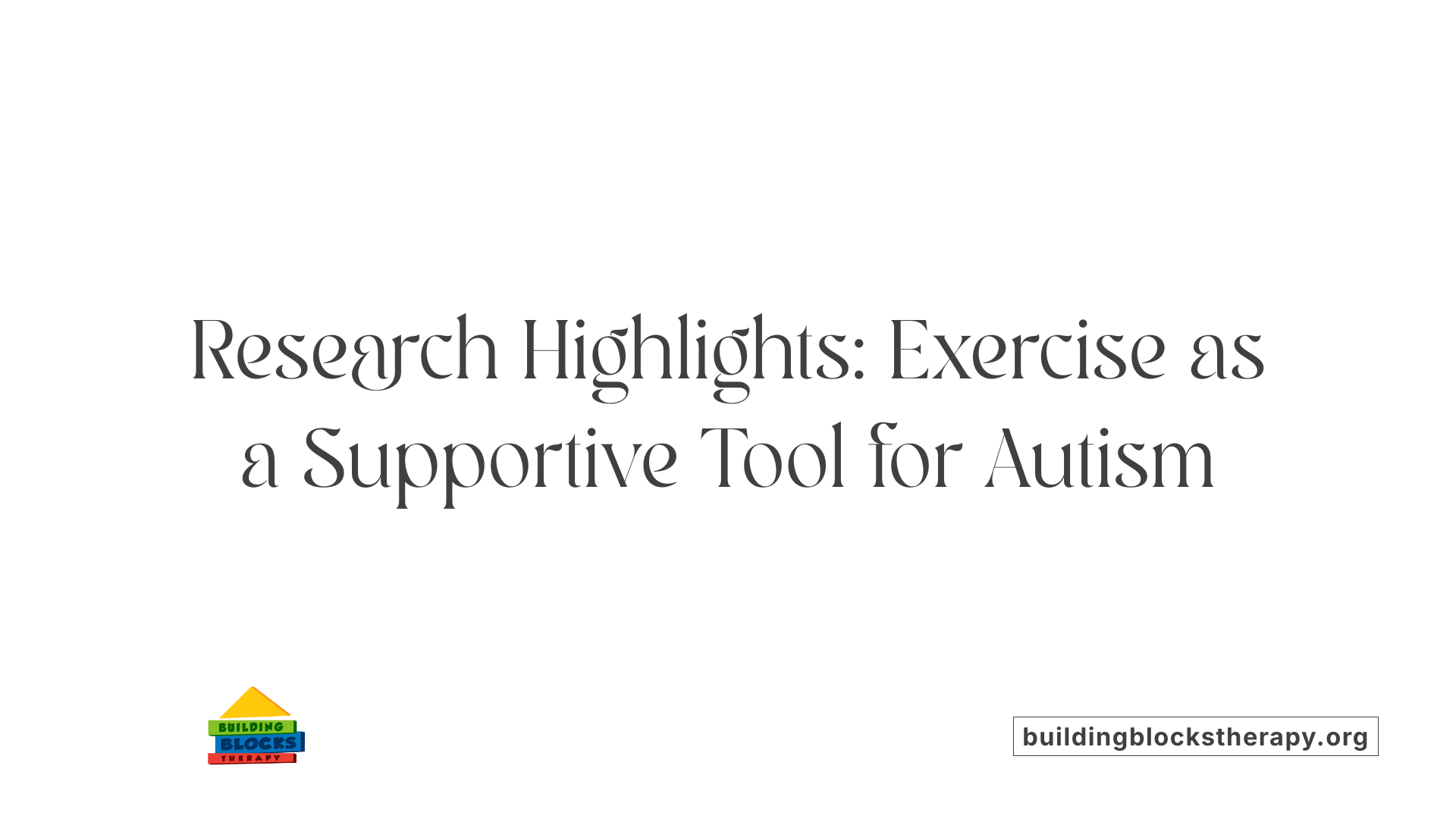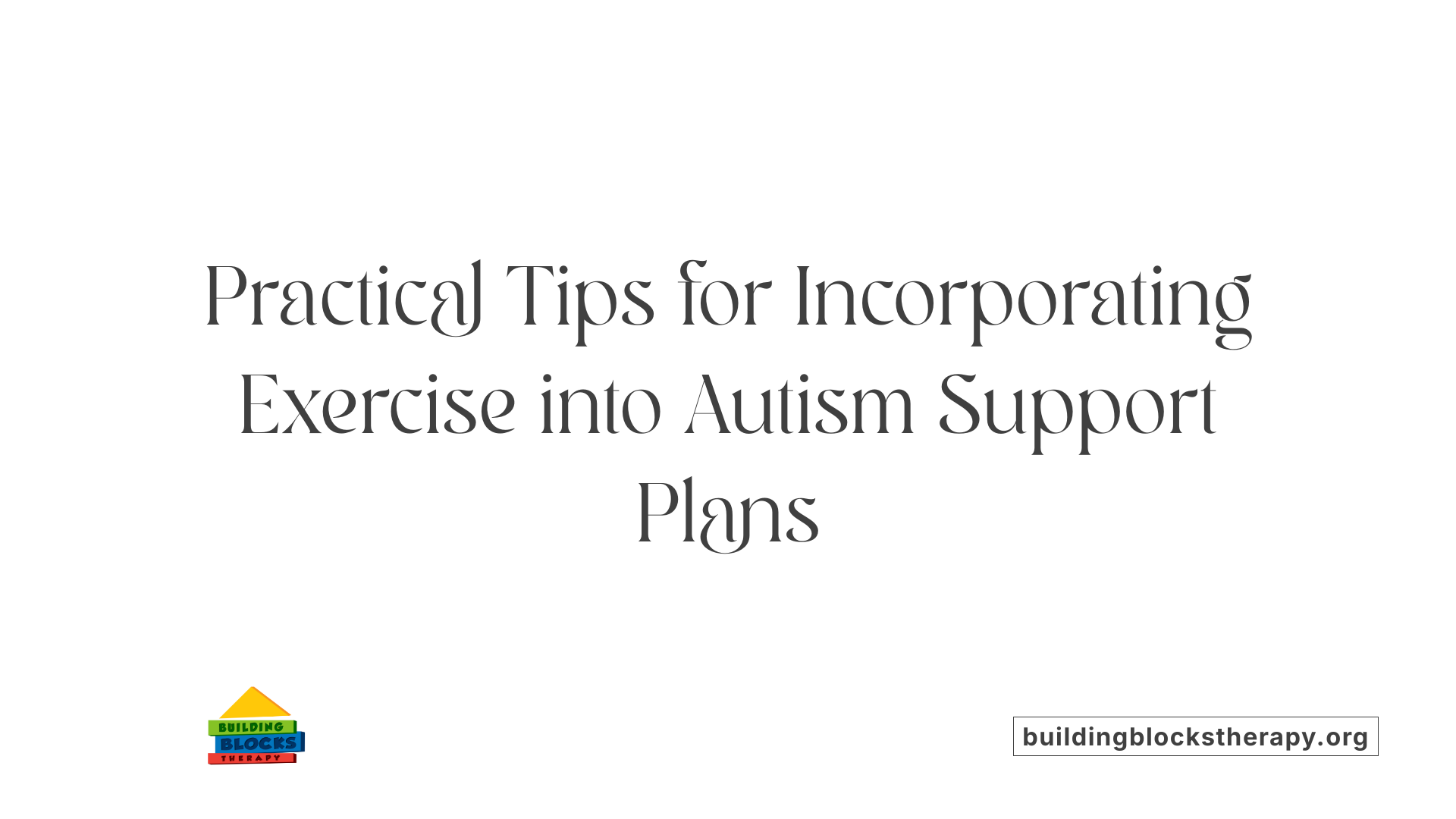Understanding the Role of Physical Activity in Autism Management
Physical activity has emerged as a promising complementary approach to support individuals with autism spectrum disorder (ASD). Scientific research indicates that tailored exercise programs can lead to meaningful improvements in social, behavioral, and motor skills, enhancing overall quality of life for those affected. This article explores how physical activity influences autism symptoms, the mechanisms underlying these effects, and practical strategies for implementation.
Benefits of Physical Activity for Individuals with Autism
What are the benefits of physical activity for individuals with autism?
Engaging in physical activity provides a wide range of positive effects for people with autism spectrum disorder (ASD). Regular exercise helps improve motor skills, including balance, coordination, and strength, which are often areas of difficulty for children and adults on the spectrum.
Activities such as swimming, martial arts like karate, horse riding, and minibasketball have been shown to enhance communication and social behaviors. These sports offer opportunities for interaction, cooperation, and nonverbal and verbal communication, fostering social development.
Besides social benefits, physical exercise also boosts cognitive functions such as attention, memory, and organizational skills. Studies indicate that structured physical activities can significantly reduce stereotypical behaviors and improve overall behavioral regulation.
Exercise programs also help in managing emotional health by reducing anxiety, stress, and sleep problems common in individuals with ASD. For example, activities like Tai Chi and kata techniques (a type of martial arts) may also support neurochemical changes conducive to better mood and social functioning.
Furthermore, tailored physical activities promote independence by enhancing physical fitness, motor planning, and daily life skills. They can also contribute to better health outcomes by reducing the risk of obesity, which is higher among individuals with autism due to challenges in motor activity and lifestyle habits.
Overall, incorporating enjoyable, meaningful, and autism-friendly exercise routines into daily life supports development, social integration, and well-being. The importance of starting small, making activities routine, and involving family or caregivers can enhance participation and long-term benefits.
Research continues to emphasize the need for more personalized programs. Nevertheless, current evidence highlights the vital role of physical activity in helping individuals with autism reach their full potential in physical, social, and emotional domains.
How Exercise Affects Autism Symptoms

How does exercise affect autism symptoms?
Engaging in physical activity can bring noticeable benefits to individuals with autism spectrum disorder (ASD). These benefits include improvements in motor skills and coordination, which help children better control their movements and balance. Activities like swimming, martial arts, and horseback riding stimulate sensory pathways and support nervous system development, enhancing overall motor proficiency.
Exercise also bolsters sensory processing, reducing sensitivities and helping children respond more comfortably to external stimuli. This can alleviate some sensory overload issues common in ASD.
Beyond physical benefits, exercise plays a significant role in emotional regulation. It increases neurotransmitters such as serotonin and dopamine, which are linked to mood regulation and feelings of well-being. As a result, children often experience reductions in anxiety, depression, and stress levels.
Many types of physical activity can decrease stereotyped behaviors, such as repetitive movements, and improve overall behavioral functioning. Additionally, participating in group activities like team sports promotes social skills, teamwork, and peer interaction, fostering better communication and social understanding.
Overall, tailored exercise routines that are engaging and adapted to individual needs can support cognitive development, reduce problematic behaviors, and improve social behaviors in those with ASD. These improvements can last beyond the activity, encouraging ongoing participation and lifelong health benefits.
Motor Skills and Autism: What Does the Evidence Say?

What is the effect of physical activity on motor skills of children with autism spectrum disorder?
A comprehensive systematic review and meta-analysis have evaluated the influence of physical activity on motor skills in children with autism. The results indicate that while physical activity programs can enhance strength, endurance, balance, and overall motor function, their impact on core motor coordination remains uncertain.
Some activities, such as swimming and horseback riding, have shown promise in improving psychomotor skills. These activities help promote gross motor proficiency, body coordination, and motor planning abilities, which are often delayed or impaired in children with ASD.
However, the evidence regarding their direct effect on fundamental motor coordination deficits, such as balance and precise movement control, is mixed. Many assessments face challenges with motor planning problems and developmental delays, making it difficult to measure definitive improvements.
Despite these limitations, engaging in regular physical activity continues to provide broad benefits. Improvements in muscle strength, endurance, and physical health are well-documented, especially when paired with specific motor skill interventions.
Types of Activities and Their Effects on Autism
What types of physical activities are beneficial for individuals with autism?
Research indicates that a variety of sports and exercises can significantly improve the developmental and behavioral symptoms in children and adults with autism spectrum disorder (ASD). For example, swimming is known to enhance psychomotor skills, increase adaptive behaviors, and foster social interaction. It also improves gross motor proficiency, which is often delayed in children with ASD.
Martial arts, such as karate, contribute to neurogenesis driven by increased brain-derived neurotrophic factor (BDNF) levels. These programs may help reduce communication difficulties and bolster memory and learning capabilities.
Horse riding, or equine therapy, provides unique benefits by improving social motivation, sensory sensitivity, and overall emotional regulation. It is particularly effective in reducing maladaptive behaviors and promoting body coordination.
Ball sports like minibasketball enhance cognitive skills and social integration, encouraging interpersonal interactions while improving motor coordination.
In addition, activities involving animals, such as horseback riding, serve as excellent opportunities for both verbal and nonverbal social engagement, helping children develop communication skills in a motivating environment.
Adapting these activities to suit individual sensory preferences and motor capabilities—such as incorporating routines, visual supports, and making activities enjoyable—can help promote sustained participation and developmental gains.
The Science Behind Physical Activity and ASD
What mechanisms and benefits of physical activity in managing autism symptoms are identified?
Physical activity influences the brain and body in multiple ways that can help reduce symptoms of autism spectrum disorder (ASD). One primary mechanism is its stimulation of neural pathways, which promotes neuroplasticity—the brain's ability to reorganize itself. Activities like swimming, martial arts, and horseback riding increase levels of neurotrophic factors such as Brain-Derived Neurotrophic Factor (BDNF), supporting neurogenesis and strengthening neural connections.
Engaging in regular exercise also affects neurotransmitter levels, including serotonin and dopamine. These chemicals play vital roles in mood regulation, attention, and social interactions. By boosting their levels, physical activity can help improve communication, reduce repetitive behaviors, and enhance social engagement.
Beyond neural effects, exercise impacts the gut microbiota—the diverse collection of microorganisms in the digestive system. Studies show that physical activity increases microbial diversity and decreases harmful bacteria like Clostridium perfringens. These microbial changes influence the gut-brain axis, a bidirectional communication network between the gastrointestinal system and the brain. Improvements in gut health can alleviate gastrointestinal issues common in children with ASD, further supporting overall behavioral and functional improvements.
Scientific evidence from systematic reviews and meta-analyses backs these mechanisms. They document that regular physical activity produces moderate to large benefits in core ASD symptoms, including better social skills, less stereotypic behavior, and improved motor functions. In sum, exercise offers a comprehensive approach, modulating neural structures, chemical signaling, and microbiota to help manage autism symptoms effectively.
Research Evidence and Meta-Analyses on Exercise in Autism

What scientific research and evidence support the impact of exercise for individuals with autism?
Numerous systematic reviews and meta-analyses underpin the positive effects of physical activity on individuals with autism spectrum disorder (ASD). A prominent meta-analysis reviewed 29 studies involving over a thousand children and adolescents, revealing that exercise programs can yield moderate to significant improvements in motor skills, social interactions, and reduction of repetitive behaviors.
A more recent comprehensive review published in 2023 included 16 studies with 587 participants. It reported a moderate effect size of 0.702, indicating that physical activity substantially alleviates core ASD symptoms such as social deficits and stereotyped behaviors. These findings reinforce the potential of exercise as an accessible, non-pharmacological strategy to support developmental progress.
Effect sizes and findings
The meta-analyses highlight specific benefits, with effect sizes demonstrating the magnitude of changes. For example:
| Outcome Area | Effect Size (SMD) | Interpretation |
|---|---|---|
| Motor performance | 1.72 | Large improvement |
| Repetitive behaviors | -0.81 | Moderate reduction |
| Social dysfunction | -0.76 | Moderate improvement |
Interventions like martial arts, horseback riding, swimming, and fundamental motor skill training have shown to improve communication, social skills, and physical fitness.
Limitations and research gaps
Despite promising results, the evidence is limited by variability in study quality. Only a few high-quality randomized controlled trials exist, and many studies suffer from high heterogeneity, especially in motor outcomes. The diversity in intervention types, durations, and participant characteristics complicates drawing definitive conclusions. More research is vital to determine optimal program design, duration, and individual tailoring.
Implications for clinical practice
Clinicians should consider integrating tailored physical activity programs, such as martial arts or horse riding, as part of a comprehensive intervention plan for individuals with ASD. Emphasizing consistency, enjoyment, and caregiver involvement can maximize benefits. Future research aimed at ensuring high methodological standards and personalization will enhance the effectiveness of exercise as a supportive therapy.
This body of evidence confirms that physical activity is a valuable tool for improving core autism symptoms, supporting social and motor skills, and potentially enhancing overall quality of life for individuals with ASD.
Practical Strategies for Implementing Physical Activity in Autism

What are practical strategies and recommendations for implementing physical activity to support individuals with autism?
Implementing physical activity programs for children and adults with autism involves a thoughtful, tailored approach. Starting with simple exercises that target fundamental motor skills—such as balance, coordination, and spatial awareness—helps build confidence and competence gradually.
Using visual supports and establishing routines makes activities more predictable and accessible for individuals with ASD. Visual timetables, demonstrations, and step-by-step instructions can help clarify expectations, reduce anxiety, and create a structured environment conducive to learning and participation.
Sampling a variety of activities is highly recommended. Trying different sports and exercises—such as swimming, martial arts, horseback riding, or walking dogs—can help identify personal preferences and motivating factors. Engaging in preferred activities increases the likelihood of sustained participation and continued development.
Caregivers and role models play a crucial role in fostering engagement. Their active participation not only demonstrates social support but also provides positive reinforcement and encouragement. This involvement can serve as motivation, especially when activities are challenging or initially unfamiliar.
Finally, making physical activities enjoyable and meaningful is vital. Tailoring activities to individual sensory sensitivities—such as modifying lighting, noise levels, or tactile elements—can reduce overwhelm. Incorporating activities that align with personal interests reinforces a positive attitude toward physical activity, promoting lifelong habits, and supporting overall well-being.
The Future of Physical Activity and Autism Research
Why is developing personalized physical activity programs important for individuals with autism?
Future research needs to focus on customizing physical activity programs to meet the individual needs of people with autism. Since ASD symptoms and motor skills vary widely, tailored interventions that consider factors like severity of autism, sensory sensitivities, and motor ability can enhance engagement and effectiveness. Personalization helps address unique barriers and builds on individual preferences, making physical activity more enjoyable and sustainable.
What are common barriers and facilitators to participation in physical activities for children with ASD?
Many children with autism face challenges such as sensory overload in noisy or bright environments, difficulty understanding complex rules, or negative social experiences like bullying. These barriers can decrease participation and enjoyment. Facilitators include adapting activities to sensory needs, simplifying rules, and creating supportive, inclusive settings. Strategies like breaking skills into small steps and making activities fun and meaningful are vital to encouraging regular engagement.
How can caregiver involvement shape the success of physical activity interventions?
Involving parents and caregivers is crucial for success. They can serve as role models, help select suitable activities, and provide encouragement. Caregiver participation can boost motivation, improve adherence, and create a positive environment for physical activity. When caregivers are engaged, children with autism are more likely to develop lifelong healthy habits and enjoy social and physical benefits.
Why is it important to promote lifelong participation in physical activity?
Evidence suggests that the benefits of physical activity—improved motor skills, better social interactions, and reduced stereotypies—can last long term. Promoting lifelong activity is essential for overall health, preventing obesity, and fostering social inclusion. Encouraging early and sustained participation, through enjoyable and accessible activities, can help individuals with autism lead healthier, more connected lives.
What is the future outlook for physical activity interventions in autism?
Looking ahead, research should aim at creating personalized, adaptive programs tailored to each individual’s needs. Overcoming obstacles like sensory sensitivities and safety concerns requires innovative strategies and supportive environments. Engaging caregivers in the process enhances success. Long-term studies are needed to understand how to maintain benefits over a lifetime and encourage continuous physical activity. Ultimately, advancing these efforts will improve overall well-being and reduce health disparities for people with autism.
Conclusion: Moving Toward Better Support and Outcomes
 Research consistently highlights the positive role of physical activity in managing autism spectrum disorder (ASD). Various studies, including systematic reviews and meta-analyses, indicate that engaging in sports and exercise programs can significantly improve motor skills, social interactions, communication, and reduce stereotypical behaviors.
Research consistently highlights the positive role of physical activity in managing autism spectrum disorder (ASD). Various studies, including systematic reviews and meta-analyses, indicate that engaging in sports and exercise programs can significantly improve motor skills, social interactions, communication, and reduce stereotypical behaviors.
Activities such as swimming, martial arts, horseback riding, and ball sports offer diverse options that cater to different interests and abilities. These interventions not only enhance physical fitness but also foster social bonding and emotional regulation. For example, swimming has been shown to boost psychomotor skills and adaptive behaviors, while karate can improve neurogenesis and memory.
Early and ongoing participation in physical activity is crucial. Initiating interventions at a young age and maintaining regular engagement—preferably more than three times weekly—can lead to better developmental outcomes. Tailoring activities to individual preferences and making them enjoyable through routines, visual supports, and role modeling encourages sustained involvement.
Despite promising results, further high-quality research remains essential. Refinement of personalized programs, understanding long-term effects, and overcoming barriers such as sensory sensitivities or safety concerns are ongoing priorities. Additionally, fostering family and community participation can support lifelong physical activity habits, which are vital given the higher risks of inactivity and obesity among individuals with autism.
In conclusion, integrating physical exercise into supportive strategies offers a promising pathway to improve core symptoms and overall quality of life for those with ASD. Continued efforts to adapt, research, and implement effective programs will help realize the full potential of physical activity as a therapeutic tool.
Moving Forward with Movement and Support
In conclusion, physical activity offers a valuable and evidence-based avenue for improving the lives of individuals with autism. By embracing tailored, enjoyable, and accessible exercise routines, caregivers and professionals can help foster development, reduce challenges, and promote well-being. Continued research and innovation are essential to optimize these interventions and ensure that everyone with autism can experience the benefits of movement.
References
- Positive effects of physical activity in autism spectrum disorder
- Autism and exercise: Special benefits
- The effect of physical exercise therapy on autism spectrum disorder ...
- Beneficial Use and Potential Effectiveness of Physical Activity in ...
- The Challenge of Physical Fitness for People With Autism
- A network meta-analysis of the effect of physical exercise on core ...
- Physical activity rates in children and adolescents with autism ...






